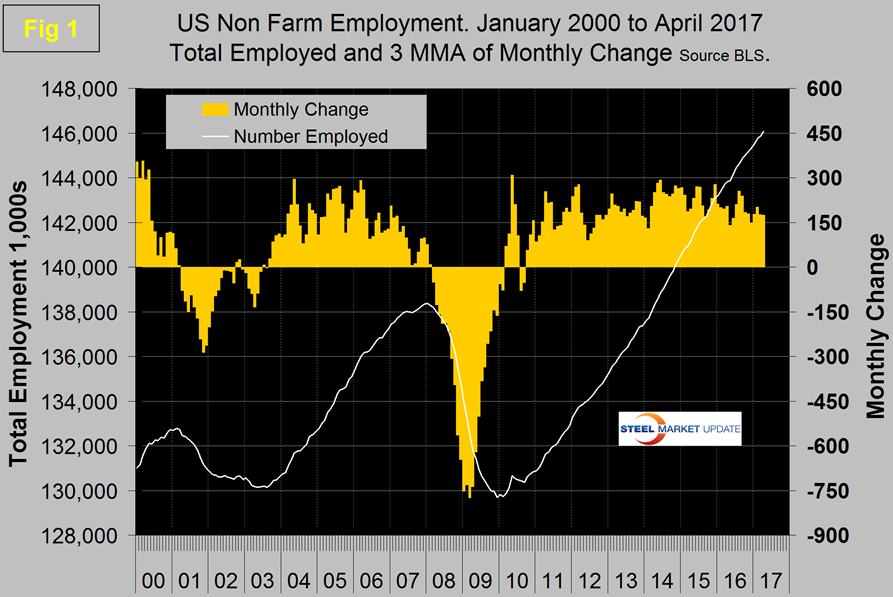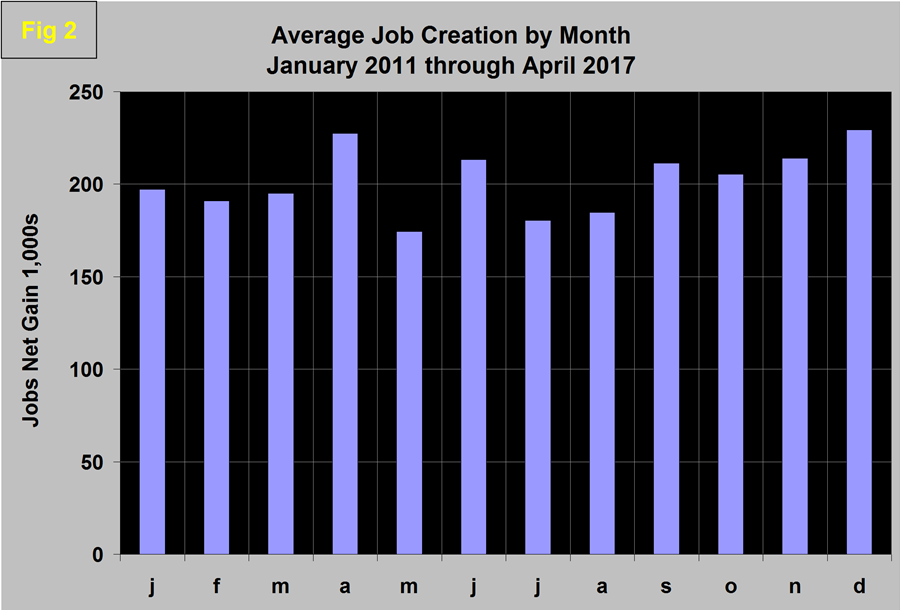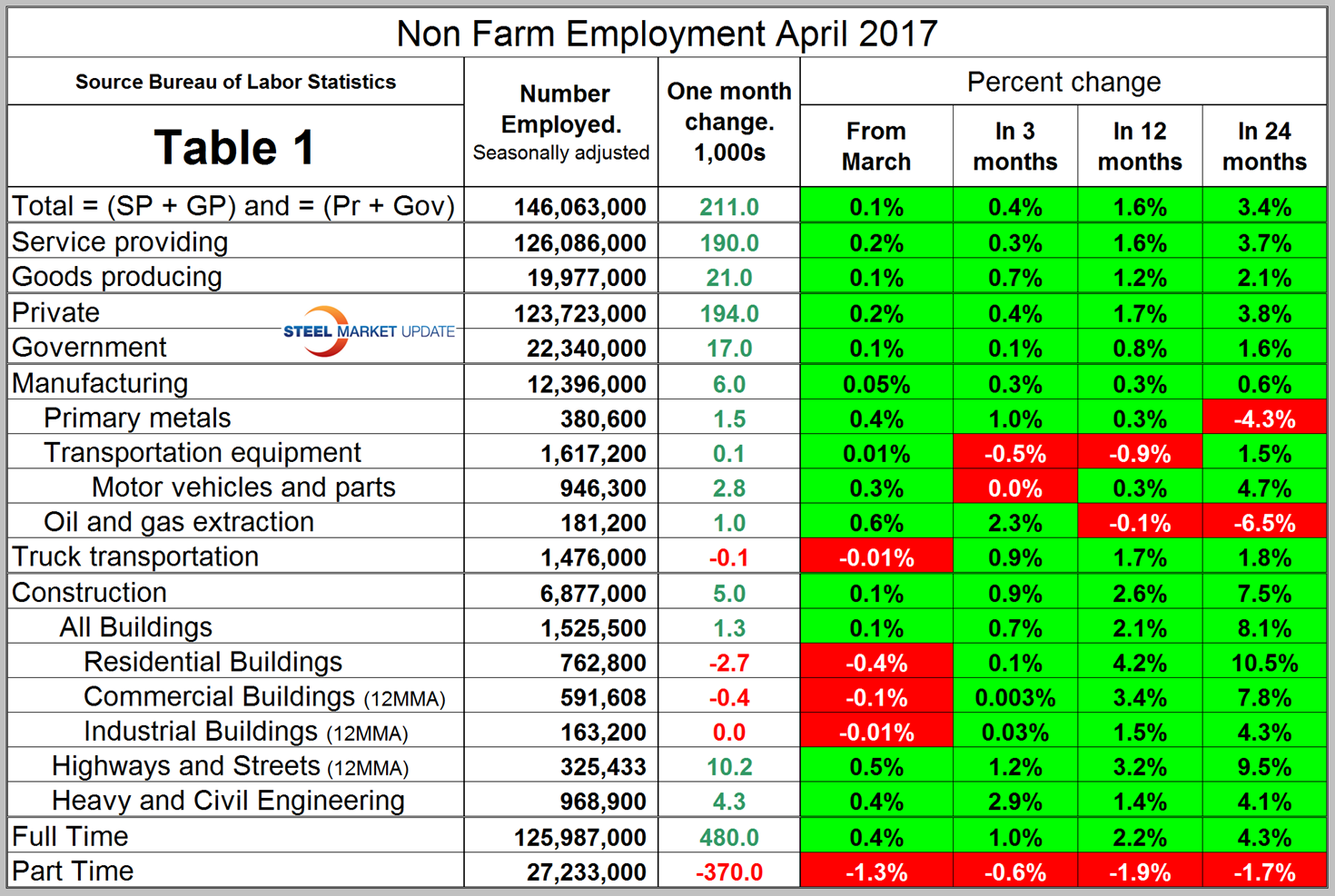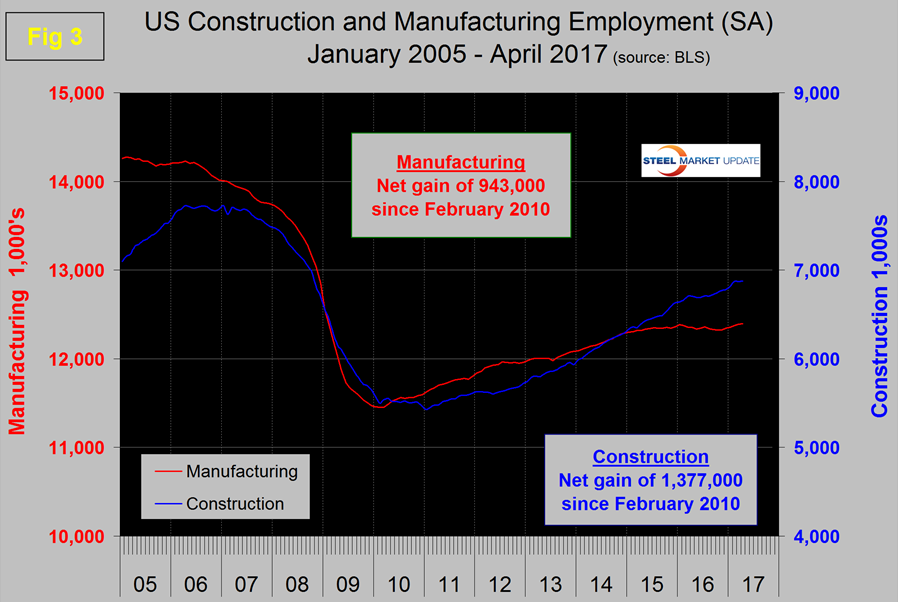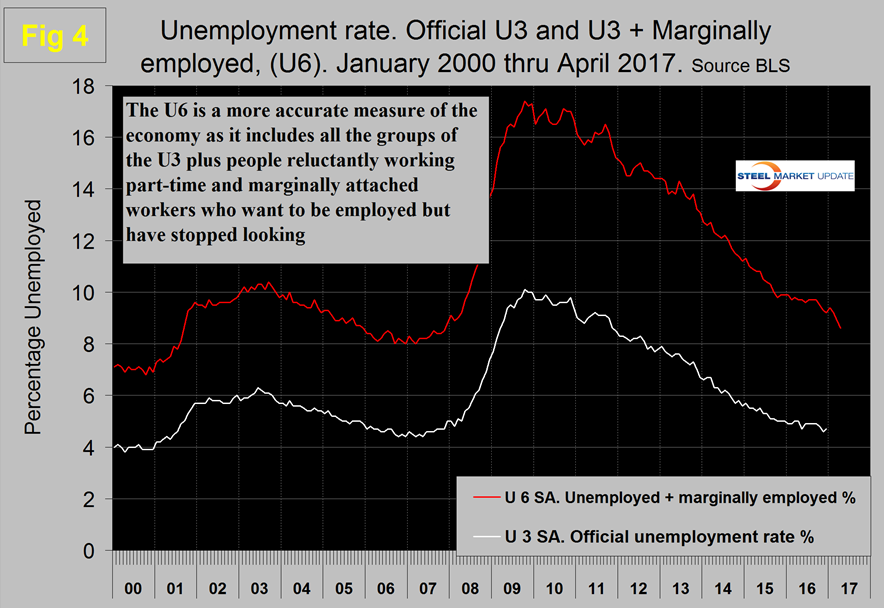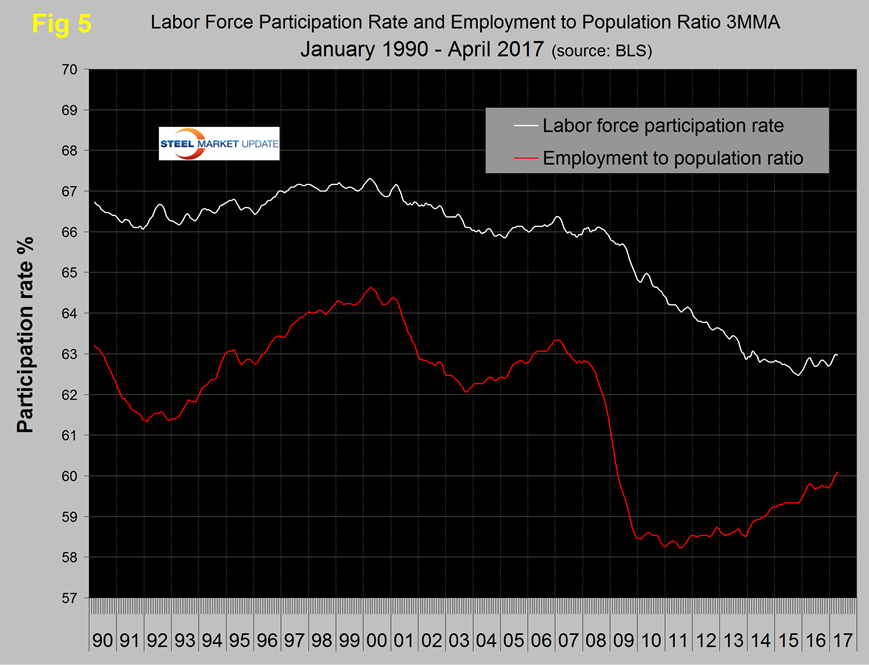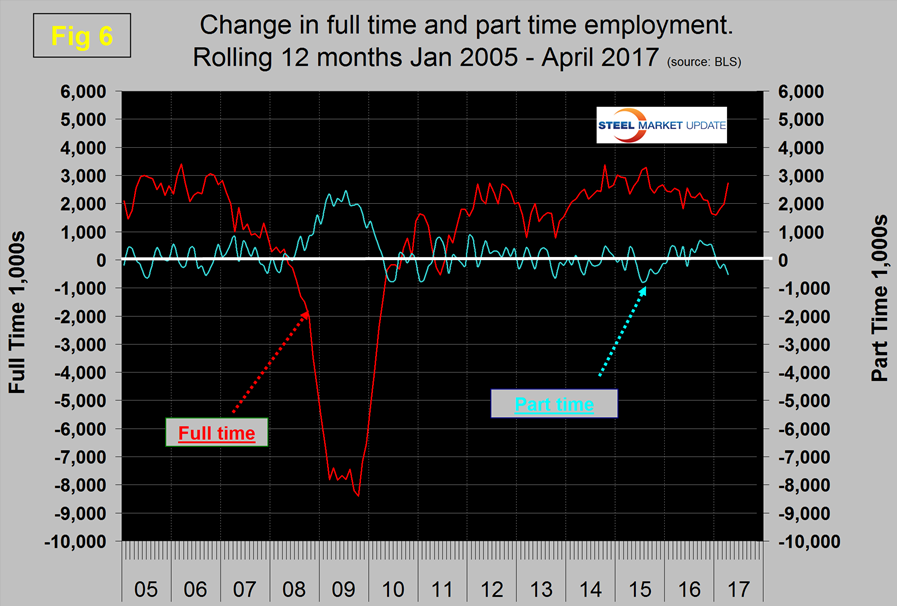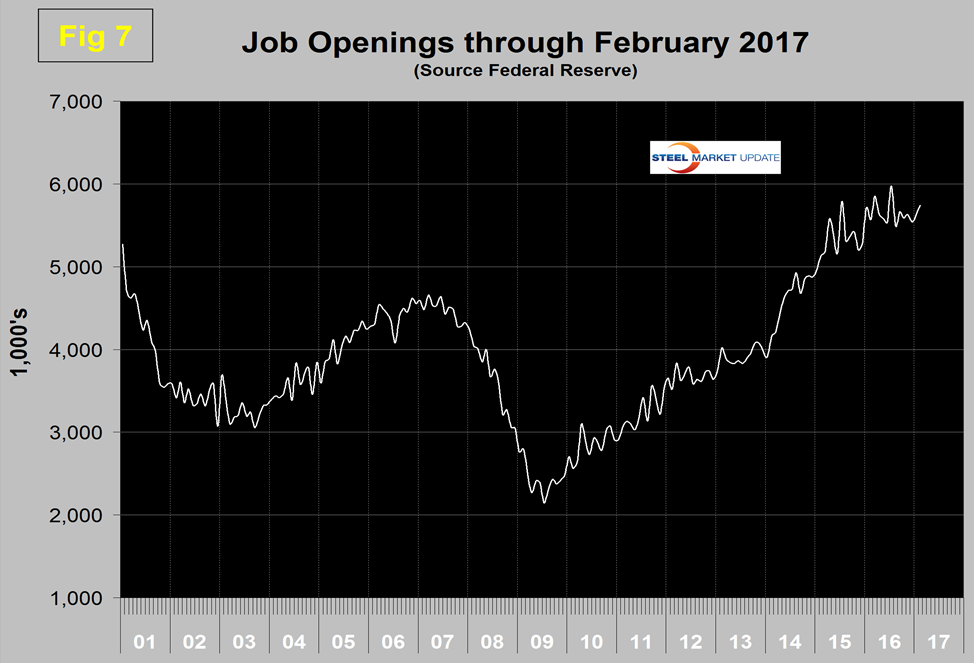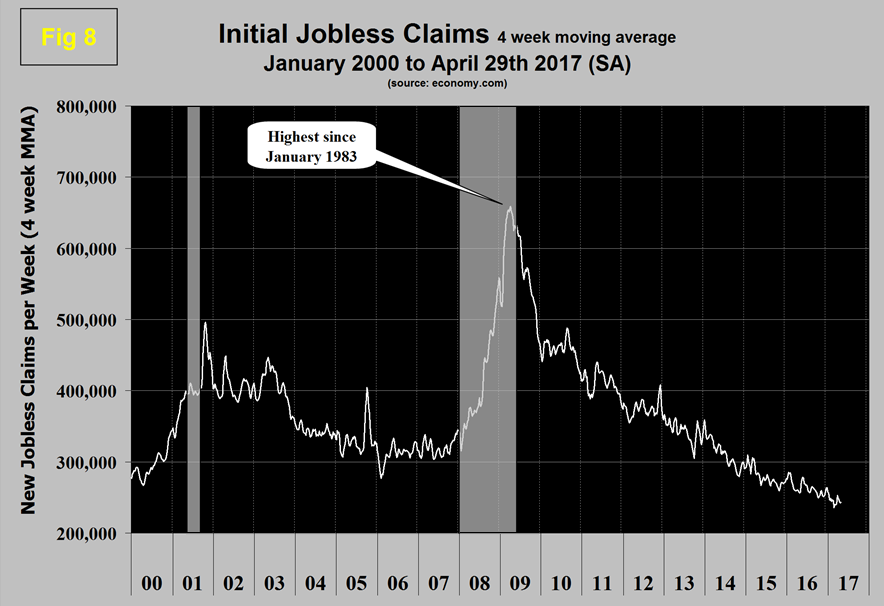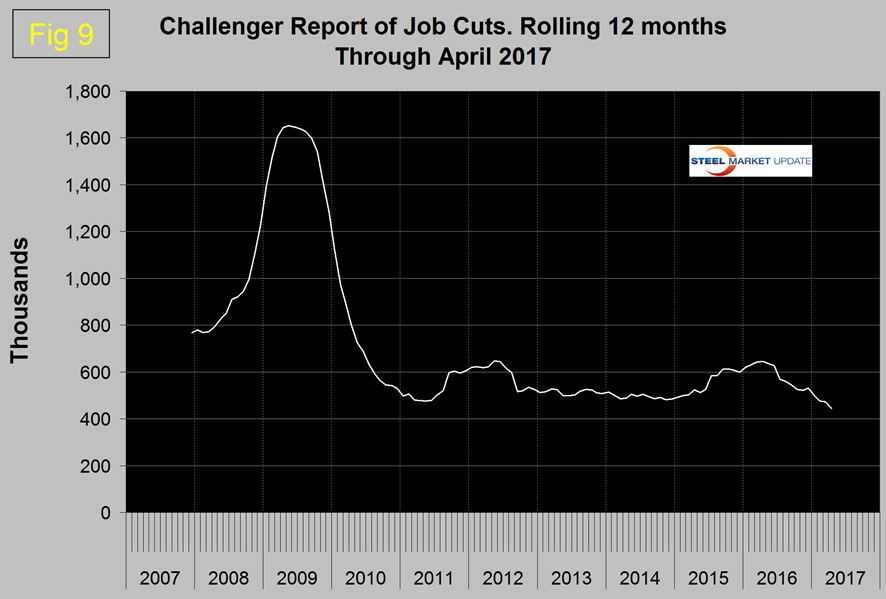Economy

Net Job Creation by Industry through April 2017
Written by Peter Wright
May 9, 2017
The US Gross Domestic Product is the values of goods and services produced by all economic activity. The growth of GDP is a function of the growth in the number of employed people multiplied by the growth of their productivity. Steel consumption is correlated to GDP, therefore to understand the direction of the steel market it is useful to know more about the growth in employment. The Bureau of Labor Statistics (BLS) monthly report of net job creation presents the big picture and also enables us to drill down into sub sectors such as manufacturing and construction. This is therefore valuable in understanding the drivers of our particular steel business.
![]() The BLS net job creation report released on Friday was another example of why we should not be fixated on a single month’s result. Month on month there was an encouraging increase following March’s poor result. March was revised down from 98,000 to 79,000 and February was revised up from 219,000 to 232,000. The April number was 211,000 with a three month moving average (3MMA) of 174,000 which was actually down from March’s 3MMA of 176,000. Clearly the single month number is useless in its ability to measure the trend. The average monthly increase in the 12 months of May 2016 through April of 2017 was 186,000. Moody’s reported that U.S. job growth rebounded in April, highlighting that the weakness in March was attributed to transitory factors. Employment rose by 211,000 which was better than either we or the consensus anticipated. Private employment increased 194,000 in April with the bulk of the growth in professional/business services, leisure/hospitality and education/healthcare. The unemployment rate fell from 4.5 percent to 4.4 percent, matching its lowest since 2006. The unemployment rate fell for the wrong reason as the labor force participation rate slipped and those not in the labor force rose. Still, the lower unemployment rate will likely fan fears within the Fed that the labor market could begin to overheat. Average hourly earnings for all private workers rose 0.3 percent. If the economy isn’t at full employment it is close.
The BLS net job creation report released on Friday was another example of why we should not be fixated on a single month’s result. Month on month there was an encouraging increase following March’s poor result. March was revised down from 98,000 to 79,000 and February was revised up from 219,000 to 232,000. The April number was 211,000 with a three month moving average (3MMA) of 174,000 which was actually down from March’s 3MMA of 176,000. Clearly the single month number is useless in its ability to measure the trend. The average monthly increase in the 12 months of May 2016 through April of 2017 was 186,000. Moody’s reported that U.S. job growth rebounded in April, highlighting that the weakness in March was attributed to transitory factors. Employment rose by 211,000 which was better than either we or the consensus anticipated. Private employment increased 194,000 in April with the bulk of the growth in professional/business services, leisure/hospitality and education/healthcare. The unemployment rate fell from 4.5 percent to 4.4 percent, matching its lowest since 2006. The unemployment rate fell for the wrong reason as the labor force participation rate slipped and those not in the labor force rose. Still, the lower unemployment rate will likely fan fears within the Fed that the labor market could begin to overheat. Average hourly earnings for all private workers rose 0.3 percent. If the economy isn’t at full employment it is close.
Figure 1 shows the 3MMA of the number of jobs created monthly as the brown bars since 2000.
The white line tracks the number employed and there hasn’t even been a blip in the trajectory of this curve in the last 12 months. The results are seasonally adjusted by the BLS. In order to examine if any seasonality is left in the data after adjustment we have developed Figure 2.
In the seven years since and including 2011, job creation in April has been up by 17.0 percent. This year April was up by 167 percent which is another way of expressing how far out of line the March result was.
Total nonfarm payrolls are now 7,698,000 more than they were at the pre-recession high of January 2008. November 2014 was the first month for total non farm employment to exceed 140 million. In April employment was over 146 million.
Table 1 breaks out the total number employed into private, government, service and goods producing industries and the change in those sectors in the latest month of data. It includes the percentage growth in three, twelve and twenty four months.
Most of the goods producing employees work in manufacturing and construction. We have identified the components of these two sectors that are most relevant to steel consumption. In April, 194,000 jobs were created in the private sector and government gained 17,000. The Federal government lost 6,000 as local governments gained 23,000 and state governments broke even. Since February 2010, the employment low point, private employers have added 16,446,000 jobs as government has shed 136,000. In April service industries expanded by 190,000 as goods producing industries driven by both construction and manufacturing expanded by 21,000. Since February 2010, service industries have added 13,980,000 and goods producing 2,350,000 positions. This is part of the reason why wage growth has been slow since the recession as service industries on average pay less than goods producing such as manufacturing.
In April, manufacturing gained 6,000 positions for a total of 53,000 in the first four months of 2017 and was 0.3 percent higher than the same month in 2016 and 0.6 percent higher than in April 2015. Table 1 shows that primary metals has done much better than manufacturing as a whole in the last three months. Transportation equipment including motor vehicles has had a small employment decrease in the last 6 months which is probably a realization that auto sales have ended their post-recession recovery. Trucking was very strong in both February and March but leveled off in April with a very small decrease. Oil and gas extraction gained 1,000 jobs in the preliminary April result which was 0.6 percent. Note the subcomponents of both manufacturing and construction shown in Table 1 don’t add up to the total because we have only included those that we think have most relevance to the steel industry.
Construction was reported to have gained 5,000 jobs in April and is up by 173,000 in the last 12 months or 2.6 percent. Some of the major construction sub categories are routinely reported one month in arrears which distorts the data in Table 1. These include, industrial buildings, commercial buildings and highways and streets. Construction has added 1,377,000 jobs and manufacturing 943,000 since the recessionary employment low point in February 2010 (Figure 3).
Construction has leapt ahead of manufacturing as a job creator but the growth of construction productivity is very low (or non-existent), in contrast to manufacturing where it is very high. The difference is the difficulty of automating construction jobs.
The official unemployment rate, U3, reported in the BLS’s Household survey (see explanation below) came in at 4.4 percent which was down from 5.0 percent in April last year. This number doesn’t take into account those who have stopped looking. The more comprehensive U6 unemployment rate was down from 9.8 percent in March last year to 8.6 percent in this latest report (Figure 4).
U6 includes workers working part time who desire full time work and people who want to work but are so discouraged that they have stopped looking. The differential between these rates was usually less than 4 percent before the recession but is still 4.2 percent. It has been estimated that the economy needs to create about 150,000 jobs per month to keep up with population growth. In the last five quarters the average monthly job creation has been 185,000 so the impact on unemployment has been about 35,000/month. The employment participation rate at 63 percent in April hasn’t changed much in the last 12 months. We’re not sure what this is a percentage “of” because of the multiple descriptions of the labor pool. Another measure is the number employed as a percentage of the population which we think is much more definitive. In April this measure was 60.2 percent up from 59.7 percent in April last year and from 59.3 percent in April 2015. Employment to population ratio has broken out of its slump in the last three months. Figure 5 shows both the participation rate and the employment to population ratio on the same graph.
In the 28 months since and including January 2015 there has been an increase of 6,053,000 full time and a decline of 273,000 part time jobs. Figure 6 shows the rolling 12 month total change in both part time and full time employment.
This data comes from the Household survey and part time is defined as < 35 hours per week. Because the full time/part time data comes from the Household survey and the headline job creation number comes from the Establishment survey, the two cannot be compared in any particular month. To overcome the volatility in the part time numbers we have to look at longer time periods than a month or even a quarter which is why we look at a rolling 12 months for this component of the employment picture shown in Figure 6.
The job openings report known as JOLTS is reported on about the 10th of the month by the Federal Reserve and is over a month in arrears. Figure 7 shows the history of unfilled job openings through February when openings stood at 5,743,000 not far off the all-time high of 5,852,000 in April last year. There has been an improving trend since mid-2009.
Initial claims for unemployment insurance, reported weekly by the Department of Labor have continued their downward drift this year and in w /e April 29th were 238,000 with a four week moving average of 243,000. This marks the longest streak since 1973 of initial claims below 300,000. (Figure 8). The result for w/e November 12th at 233,000 was the lowest since April 1974.
The last piece of the employment puzzle that we examine is the Challenger report which measures job cuts monthly (Figure 9).
This data also tends to be quite erratic therefore again we examine a rolling 12 months and can see that job cuts decreased for most of 2016 and continued their downward trend in 2017.
SMU Comment: Overall we think the employment situation is very good and has been described as “full” by some analysts. April 2017 was the 85th consecutive month of job growth on a 3MMA basis. Since January 1940, the mid-90s was the longest sustained period of job growth when the streak was 96 months. It is encouraging that primary metals had a better rate of job growth than manufacturing as a whole for two reasons. First it is our industry but, in addition, this should presage a positive future for manufacturing in the balance of 2017. New unemployment claims are at a historic low, job cuts are down and job openings are way up. Not a bad picture.
Explanation: On the first Friday of each month the Bureau of Labor Statistics releases the employment data for the previous month. Data is available at www.bls.gov. The BLS reports on the results of two surveys. The Establishment survey reports the actual number employed by industry. The Household survey reports on the unemployment rate, participation rate, earnings, average workweek, the breakout into full time and part time workers and lots more details describing the age breakdown of the unemployed, reasons for and duration of unemployment. At SMU we track the job creation numbers by many different categories. The BLS data base is a reality check for other economic data streams such as manufacturing and construction and we include the net job creation figures for those two sectors in our “Key Indicators” report. It is easy to drill down into the BLS data base to obtain employment data for many sub sectors of the economy. For example, among hundreds of sub-indexes are truck transportation, auto production and primary metals production. The important point about each of these hundreds of data streams is in which direction they are headed. Whenever possible we at SMU try to track three separate data sources for a given steel related sector of the economy. We believe this gives a reasonable picture of market direction. The BLS data is one of the most important sources of fine grained economic data that we use in our analyses. The States also collect their own employment numbers independently of the BLS. The compiled state data compares well with the federal data. Every three months SMU examines the state data and provides a regional report which indicates strength of weakness on a geographic basis. Reports by individual state can be produced on request.

Peter Wright
Read more from Peter WrightLatest in Economy

Fed Beige Book: Economy improves, but manufacturing weak
While general economic conditions across the US improved slightly over the last six weeks, activity in the manufacturing sector was weak, according to the Fed’s latest Beige Book report.

SMU Community Chat: Simonson with the latest on construction
A lot of economists were predicting a recession last year. Ken Simonson, chief economist for The Associated General Contractors of America (AGC), wasn’t one of them.

Housing starts slip to seven-month low in March
Following a strong February, US housing starts eased through March to a seven-month low, according to the most recent data from the US Census Bureau.

Manufacturing activity in New York state continues to soften
New York state saw a continued decline in manufacturing activity in April, according to the latest Empire State Manufacturing Survey from the Federal Reserve Bank of New York

Worldsteel projects steel demand to grow 1.7% this year
Global steel demand will reach roughly 1.793 million metric tons (1.976 million short tons) this year, an increase of 1.7% over 2023, the World Steel Association (worldsteel) said in its updated Short Range Outlook report. The gain will come after a 0.5% contraction in steel demand in 2023. Demand is forecasted to increase another 1.2% […]

